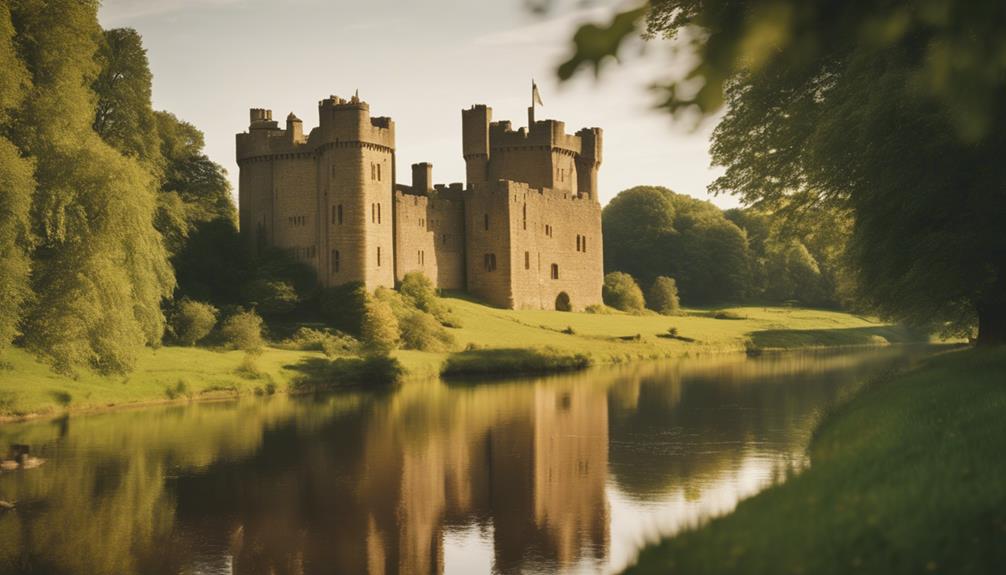Exploring Staffordshire's Rich History Through Its Castles
Uncover Staffordshire's rich history by exploring its enchanting castles, each filled with unique stories and architectural marvels. Start with Stafford Castle, built in 1073, showcasing Norman and Tudor construction techniques. At Tamworth Castle, experience legends of ghostly apparitions and ties to royal intrigue. Tutbury Castle offers dramatic tales, including the imprisonment of Mary, Queen of Scots. Eccleshall Castle evolves from a motte and bailey to a stone keep with Tudor charm. Alton Towers blends Gothic Revival history with contemporary fun. Chartley Castle and Maxstoke Castle present medieval architecture and mysterious legends. Discover more about these historic fortresses and their fascinating transformations.
Key Points
- Stafford Castle showcases Norman architecture and advanced building techniques from 1073, embodying Staffordshire's medieval history.
- Tamworth Castle's ties to royal intrigues and ghostly legends highlight its significance in Staffordshire's historical and cultural landscape.
- Tutbury Castle's dramatic sieges and Mary, Queen of Scots' imprisonments offer a glimpse into turbulent historical events.
- Eccleshall Castle's evolution from a motte and bailey to a Tudor-style stone keep reflects architectural advancements through centuries.
- Alton Towers' transformation from a Gothic Revival mansion to a modern theme park blends historical roots with contemporary appeal.
Stafford Castle's Origins
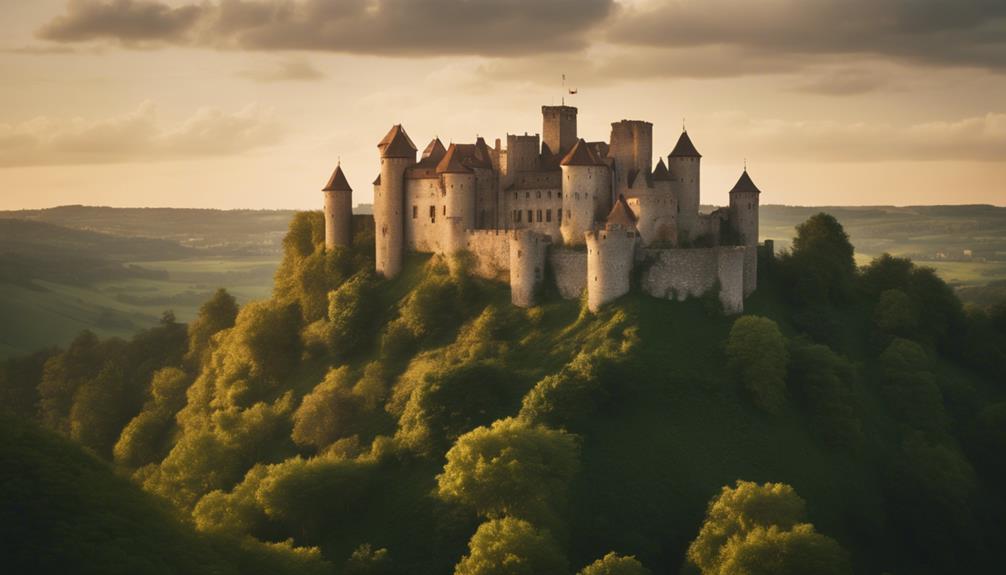
When you explore Stafford Castle, you'll discover it was originally built as a motte and bailey structure by the Normans in 1073. This initial construction marked the beginning of its journey through English heritage. As you walk through its grounds, you'll be standing on land that has witnessed the impact of the Norman conquest and the subsequent architectural marvels that followed.
The medieval origins of Stafford Castle are evident in its design and layout. A century after its initial construction, the stone shell keep was added, showcasing the castle's architectural evolution. This addition not only fortified the structure but also demonstrated the advanced building techniques of the time. The stone keep stands as a reflection of the ingenuity and craftsmanship of medieval builders.
As you explore further into its history, you'll find that Stafford Castle isn't just a relic of the past, but a vibrant part of England's story. Each stone and timber speaks of the Norman conquest and the rich tapestry of events that have shaped the castle over the centuries. Embrace the sense of belonging that comes from being part of this enduring legacy.
Tamworth Castle Legends
Tamworth Castle, constructed in 1073 by the Normans, stands as a tribute to the legends and historical events that have shaped its storied past. As you wander through its ancient halls, you'll come across tales of ghostly apparitions and hidden treasures that have fascinated visitors for centuries. The castle's long history is filled with mysterious sightings, including that of a spectral lady believed to haunt the Great Hall.
Furthermore, Tamworth Castle is steeped in stories of ancient curses that are said to have afflicted those who dared to disturb its secrets. These curses create an aura of mystery, turning every creaking floorboard and shadowy corner into a potential gateway to the unknown.
The castle's ties to royal intrigues also enhance its story. From its days of strategic significance during the English Civil War to its involvement in the power struggles between Saxons and Normans, Tamworth has silently witnessed crucial moments in history.
Today, the castle's involvement in community events and educational programmes allows you to immerse yourself in its complex past, providing a sense of connection to a legacy that continues to endure.
Tutbury Castle Tales
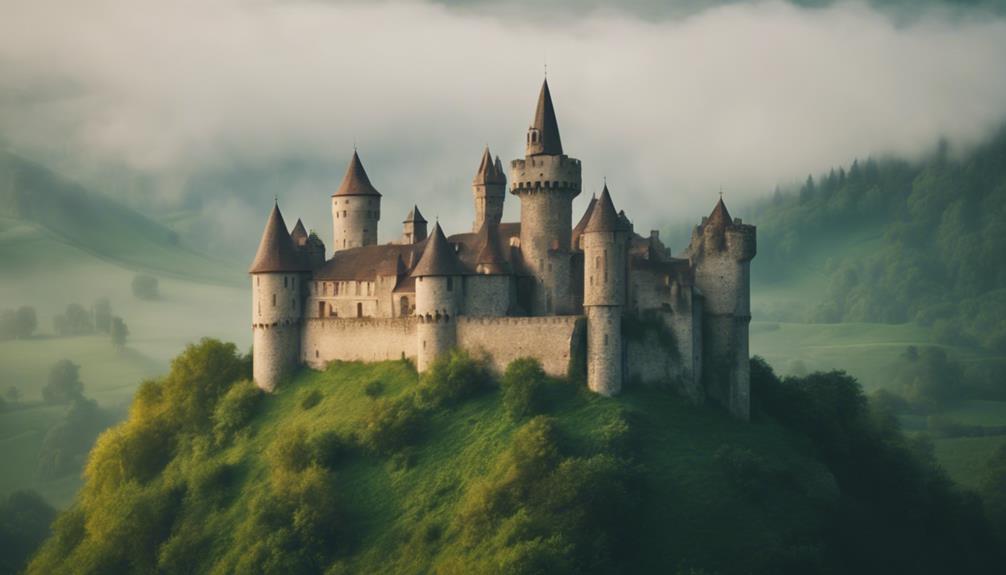
Just as Tamworth Castle enchants with its legends and mysteries, Tutbury Castle captivates with tales of royalty, imprisonment, and dramatic sieges.
When you visit Tutbury Castle, you're stepping into a world where Mary, Queen of Scots faced multiple imprisonments. Imagine the tension and drama as she plotted escapes and navigated the web of royal intrigue that defined her life.
The castle's history isn't just about Mary, though. It's a site that witnessed numerous dramatic sieges, with its walls echoing the clamour of battles fought for control over centuries. You'll find that each stone tells a story of power struggles and resilience.
By joining a guided tour, you'll uncover these stories in vivid detail. Enthusiastic guides bring the past to life, sharing tales that make you feel part of this rich tapestry. Events and reenactments further immerse you in the castle's storied past, making history tangible.
As you explore the ruins, you'll be struck by the medieval architecture and panoramic views that make Tutbury Castle a must-visit. It's a place where history isn't just remembered; it's experienced, making you feel connected to the past.
Eccleshall Castle's Evolution
Exploring Eccleshall Castle, you'll observe its remarkable transformation from a 12th-century motte and bailey structure into a stone keep that stands as a proof to evolving architectural styles.
Walking through the castle, you can see the Medieval influences in its sturdy stone walls and defensive design. The Great Hall, with its impressive nine-metre tie beam roof and intricate oak panelling, showcases the craftsmanship of a bygone era.
As you explore further, you'll notice the Tudor additions, characterised by expert dowels and carvings that add a layer of historical charm. Eccleshall Castle's restoration over the centuries has preserved these elements, allowing you to step back in time and experience its grandeur firsthand.
Further modernisation came with the Townsend family, who introduced Georgian-style windows and iron fireplaces. These updates reflect a blend of historical periods, creating a unique architectural tapestry.
Each phase of transformation tells a story, making Eccleshall Castle a living museum of architectural evolution.
Alton Towers' Historic Roots
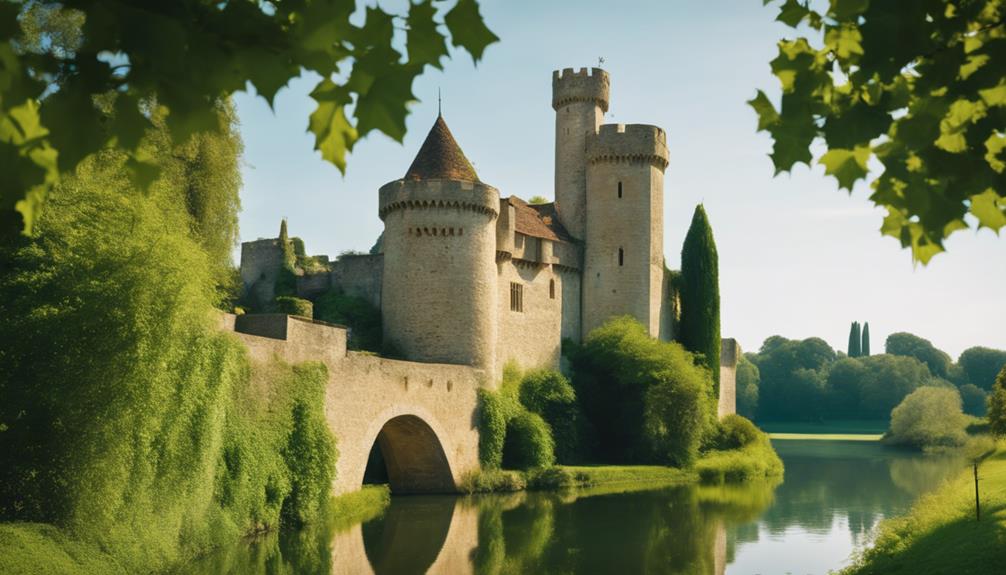
Discover Alton Towers' enchanting past, where its origins as an 11th-century hunting ground for the Earl of Stafford set the stage for its evolution into a renowned 19th-century Gothic Revival mansion and modern theme park. As you wander through its historic grounds, you'll find remnants of medieval architecture that speak volumes about its cultural heritage. The estate's transformation over centuries has turned it into a fascinating blend of history and entertainment.
By the 19th century, Alton Towers had become a stunning Gothic Revival mansion, attracting visitors who were keen to marvel at its grandeur. Today, the estate is not just about its past; it's also home to one of the UK's most popular theme parks. Opened in 1980, the theme park offers an array of modern attractions that delight visitors of all ages.
| Historic Element | Description | Significance |
|---|---|---|
| 11th-century origins | Originally a hunting ground for the Earl of Stafford | Lays the foundation |
| Gothic Revival mansion | 19th-century architectural transformation | Showcases medieval architecture and cultural heritage |
| Theme park opening | Established in 1980 | Marks the start of modern theme park history |
| Modern attractions | Rides, entertainment, and accommodation | Blends historical roots with contemporary fun |
Exploring Alton Towers, you experience a unique connection to both the past and present, offering something for everyone.
Chartley Castle Remains
You can explore the historical significance of Chartley Castle, which stands as a testament to medieval architecture and its strategic importance. Its 12th-century motte and bailey design reveals much about the defensive techniques of the time.
As you wander among its picturesque ruins, you'll uncover stories of notable figures like Robert de Ferrers and the castle's role during the English Civil War.
Historical Significance Revealed
Chartley Castle's remains stand as a testament to Staffordshire's tumultuous history and architectural legacy. Dating back to the 12th century, this castle has witnessed significant historical events, including its role in the Wars of the Roses and its use as a refuge for Mary Queen of Scots during her captivity. As you wander through its ruins, you can't help but feel a connection to the past.
Efforts in castle restoration and preservation have ensured that Chartley Castle's ruins remain accessible to those eager to explore its historical significance. The ruins, which include a gatehouse, curtain walls, and a tower, provide a glimpse into medieval architecture and the castle's importance in England's history. Chartley Castle is also a Grade II listed building, highlighting its cultural and historical significance.
| Aspect | Details |
|---|---|
| Built | 12th Century |
| Historical Events | Wars of the Roses, Mary Queen of Scots |
| Architectural Features | Gatehouse, Curtain Walls, Tower |
| Current Status | Grade II Listed Structure |
Visiting Chartley Castle allows you to step back in time, envisioning the lives of those who once roamed its halls. It serves as a poignant reminder of Staffordshire's rich and varied past, inviting you to participate in its preservation for future generations.
Architectural Design Insights
Amidst the ruins of Chartley Castle, the architectural design offers a fascinating glimpse into medieval and later historical periods. You'll notice the enduring influence of medieval architecture in the motte and bailey structure, a hallmark of early fortification design.
The 13th-century stone keep stands as a confirmation to medieval influences, showcasing thick walls and narrow windows designed for defence.
As you explore further, the great hall captures your attention with its impressive tie beam roof spanning nine metres. This feature highlights the intricate architectural details that made such grand interiors possible.
Also, you'll find Tudor construction elements, such as dowels and intricate carvings, which add a touch of elegance and historical charm to the castle.
Venture inside to see furnishings that reflect various historical periods. Georgian fireplaces and Stuart period four-poster beds provide a unique glimpse into the lifestyles of those who once inhabited the castle.
These architectural details and furnishings not only tell a story of evolving design but also create a sense of connection to the past.
Chartley Castle's remains invite you to step back in time and experience the rich history embedded in its walls.
Maxstoke Castle Mysteries
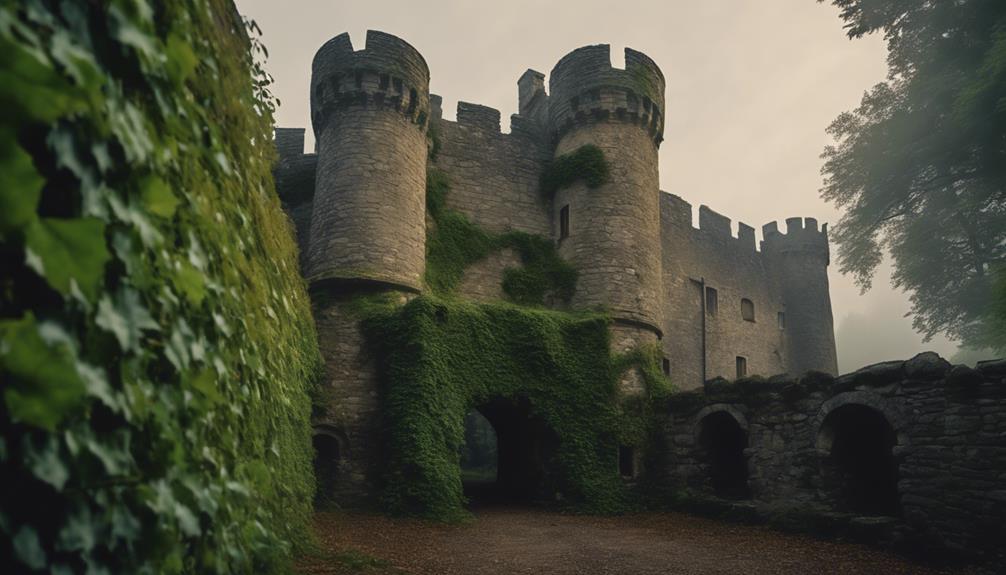
Maxstoke Castle, a jewel of medieval architecture, holds many secrets waiting to be uncovered. As you wander through its ancient halls, you'll hear whispers of secret tunnels and hidden treasures. Legends suggest that beneath the stone floors lie passages that once provided escape routes or concealed valuable artefacts. Imagine the thrill of discovering a chest of long-lost riches!
The castle also has its share of ghostly sightings and paranormal activity. Some visitors claim to have seen shadowy figures in the great hall or heard unexplained footsteps echoing through the corridors. These eerie experiences add a layer of mystery to Maxstoke Castle, making each visit an adventure into the unknown.
| Mystery | Description | Experience Level |
|---|---|---|
| Secret Passageways | Hidden escape routes, treasures | High |
| Ghostly Sightings | Shadowy figures, eerie noises | Medium |
| Paranormal Activity | Unexplained phenomena | High |
| Historical Artefacts | Medieval relics, fishpond complex | Low |
Exploring Maxstoke Castle isn't just about admiring its architecture; it's about connecting with a part of history that feels both distant and immediate. You'll feel a sense of belonging as you uncover the stories that shaped this remarkable place. So, step into Maxstoke's past and let its mysteries captivate your imagination.
Staffordshire's Medieval Castles
Staffordshire's medieval fortresses, like Stafford Castle and Tamworth Castle, offer a fascinating glimpse into the region's rich and tumultuous history. When you visit Stafford Castle, you'll be struck by its impressive castle architecture. The stone shell keep stands tall, while the tie beam roof in the Great Hall and Tudor construction features reflect its grandeur. Intricate carvings add to the historical charm, making you feel connected to the medieval tales that shaped the castle's past.
Tamworth Castle, on the other hand, carries stories of Aethelflade, the Lady of the Mercians, and its strategic importance during the Norman conquest. Imagine the fierce battles during the English Civil War when the castle was held for King Charles I. The architecture here tells its own tales, from robust fortifications to the adaptations made over centuries.
Both castles have evolved, incorporating elements like iron fireplaces and Georgian-style windows, yet they retain their medieval essence. By engaging with these fortresses, you're not only exploring history but also becoming part of a community dedicated to preserving local heritage. Educational programmes and tours offer deeper insights, ensuring these medieval stories live on for future generations.
Castle Ruins and Renovations
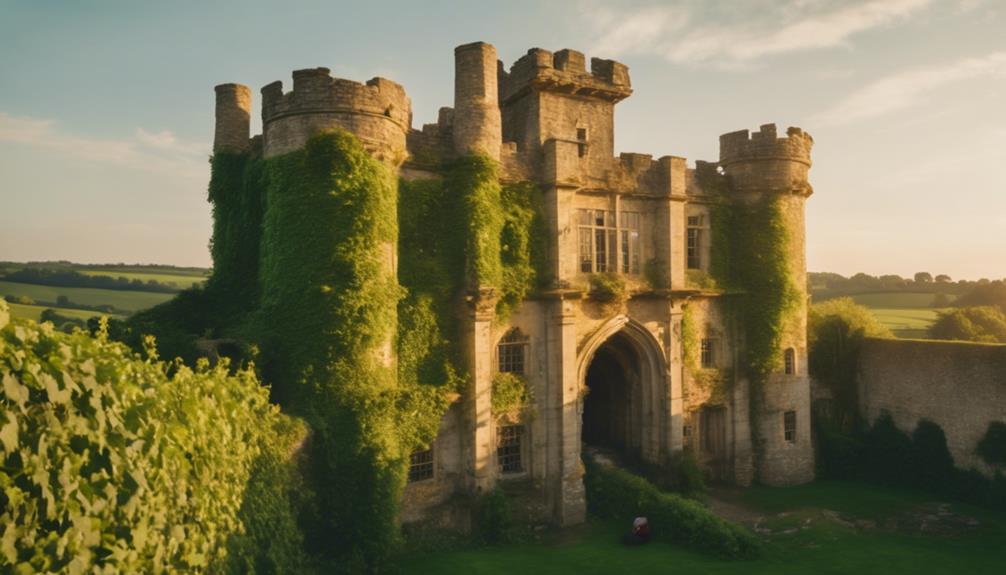
As you explore the medieval fortresses, you'll also encounter the intriguing ruins and remarkable renovations that reveal Staffordshire's ongoing efforts to preserve its historic castles. Stafford Castle, for instance, presents a fascinating blend of ancient ruins and modern restoration challenges. Originally a motte and bailey, it transformed into a stone shell keep, with traces of its Tudor influences still visible in the dowels, carvings, and elaborate oak panelling.
Preservation efforts face numerous challenges, particularly when dealing with centuries-old structures. The delicate balance between maintaining historical integrity and implementing necessary repairs requires careful planning. Artistic interpretations play an important role, with experts working to stay true to the original architectural transformations while adapting to modern preservation techniques.
One notable example is the Great Hall at Stafford Castle. Its nine-metre tie beam roof and collection of swords showcase the castle's rich history. The Townsend family's Georgian-style windows and iron fireplaces are another reflection of ongoing architectural transformations. Despite financial struggles, these additions reflect the continuous evolution of the castle's structure.
Ultimately, Staffordshire's commitment to preserving its castles connects you to a shared history, enriching the sense of belonging to this storied region.
Frequently Asked Questions
How Many Castles Are There in Staffordshire?
You'll find several fascinating castles in Staffordshire, each showcasing unique castle architecture and medieval defences. Notable ones include Stafford and Tamworth Castles. Visiting these sites helps you feel connected to the region's rich historical heritage.
What is the history of Stafford?
You're stepping into Stafford's rich tapestry, where Roman settlements laid roots and Medieval markets bustled with life. This town's vibrant history, from Saxon to Tudor eras, offers you a sense of belonging through time.
Why is Staffordshire famous for?
You would adore Staffordshire for its pottery heritage and industrial development. Stoke-on-Trent's ceramics history and Burton-upon-Trent's brewing origins would make you feel part of a rich tradition. Explore iconic locations and feel a sense of connection to the past.
What happened to Stafford Castle?
You'd find Stafford Castle fascinating. It underwent restoration, revealing significant archaeological finds. The local council now manages it, offering educational programmes to connect the community with its rich history and ensure its preservation for future generations.
Conclusion
Exploring Staffordshire's castles offers a fascinating glimpse into the region's rich history. You can uncover ancient origins at Stafford Castle, delve into legends at Tamworth Castle, and unravel tales at Tutbury Castle.
Eccleshall Castle's evolution and Alton Towers' historic roots add depth, while Chartley Castle's remains and Maxstoke Castle's mysteries captivate your imagination.
From medieval fortresses to castle ruins and renovations, Staffordshire's storied past is waiting for you to discover and appreciate.
